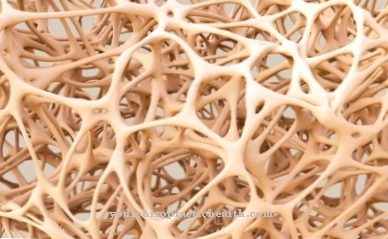The Depolarization is the cancellation of the charge differences on the two membrane sides of a nerve or muscle cell. The membrane potential changes to a less negative one. In diseases such as epilepsy, the depolarization behavior of the nerve cells changes.
What is the depolarization?

In the resting state, polarization exists between the two sides of an intact nerve cell membrane, which is also known as the membrane potential. The separation of charges creates electrical poles in the cell membrane. Depolarization is the loss of these properties as it occurs at the beginning of a stimulation. During depolarization, the difference in charge between the two sides of a biological membrane cancels out for a short time.
In neurology, depolarization is understood to mean the change in the membrane potential into positive or less negative values, as occurs when an action potential is passed through. The reconstruction of the original polarization takes place towards the end of this process and is also known as repolarization.
The opposite of depolarization is what is known as hyperpolarization, in which the tension between the inside and outside of a biological membrane becomes even stronger and thus rises above the tension of the resting potential.
Function & task
The membranes of healthy cells are always polarized and therefore have a membrane potential. This membrane potential results from the different ion concentration on the two sides of the membrane. For example, ion pumps are located in the cell membrane of neurons. These pumps permanently create an uneven distribution on the membrane surface, which differs from the charge on the inside of the membrane. Intracellular there is an excess of negative ions and the cell membrane is more positively charged on the outside than on the inside. This results in a negative potential difference.
The cell membrane of the neurons has selective permeability and is therefore differently permeable to different charges. Because of these properties, a neuron has an electrical membrane potential. In the resting state, the membrane potential is called the resting potential and is around −70 mV.
Electrically conductive cells depolarize as soon as they reach an action potential. The membrane charge is weakened during the depolarization, as ion channels open. Ions flow into the membrane through the opened channels by means of diffusion and thus reduce the existing potential. For example, sodium ions flow into the nerve cell.
This shift in charge balances the membrane potential and thus reverses the charge. In the broadest sense, the membrane is still polarized during an action potential, but in the opposite direction.
In nerve cells, depolarization is either subliminal or supra-threshold. The threshold corresponds to the threshold potential for the opening of the ion channels. Usually the threshold potential is around −50 mV. Larger values move the ion channels to the opening and trigger an action potential. Subliminal depolarization causes the membrane potential to return to the resting membrane potential and does not trigger any action potential.
In addition to nerve cells, muscle cells can also be depolarized when they reach an action potential. The excitation is transmitted from central nerve fibers to muscle fibers via the motor endplate. The end plate has cation channels that can conduct sodium, potassium and calcium ions. Above all, sodium and calcium ion currents flow through the channels due to their special driving forces and thus depolarize the muscle cell.
In the muscle cell, the endplate potential increases from the resting membrane potential to the so-called generator potential. This is an electrotonic potential that, unlike the action potential, spreads passively across the membrane of the muscle fibers. If the generator potential is above threshold, an action potential is created through the opening of the sodium channels and calcium ions flow in. This is how muscle contraction occurs.
Illnesses & ailments
In nervous system diseases such as epilepsy, the natural depolarization behavior of the nerve cells changes. Over-excitability is the result. Epileptic seizures are characterized by an abnormal discharge of neural associations that disrupt the normal activity of the areas of the brain. This results in unusual perceptions and disorders of motor skills, thinking and consciousness.
Focal epilepsy affects the limbic system or the neocortex. A glutamatergic transmission triggers an excitatory postsynaptic potential with high amplitude in these areas. In this way, the membrane's own calcium channels are activated and undergo a particularly long-lasting depolarization. In this way, high-frequency bursts of action potentials are triggered, as they are characteristic of epilepsy.
The abnormal activity spreads in an aggregate of several thousand nerve cells. An increased synaptic connectivity of the neurons also contributes to the generation of the seizures. The same is true for abnormal intrinsic membrane properties, which mainly affect the ion channels. The synaptic transmission mechanisms are also often changed in terms of receptor modifications. Persistent seizures are probably the result of synaptic loop systems that can encompass larger areas of the brain.
The depolarization properties of nerve cells change not only in epilepsy. Numerous drugs also have effects on the depolarization and are expressed either in over- or under-excitability. These drugs include, for example, muscle relaxants that completely relax the skeletal muscles by intervening in the central nervous system.
The administration is common for spinal spasticity, for example. Especially depolarizing muscle relaxants have a stimulating effect on the muscle receptor and thus initiate a long-lasting depolarization. In the beginning, the muscles contract after the medication and trigger uncoordinated muscle tremors, but shortly afterwards they cause flaccid paralysis of the respective muscles. Since the depolarization of the muscles persists, the muscle is momentarily inexcitable.

















.jpg)







.jpg)


